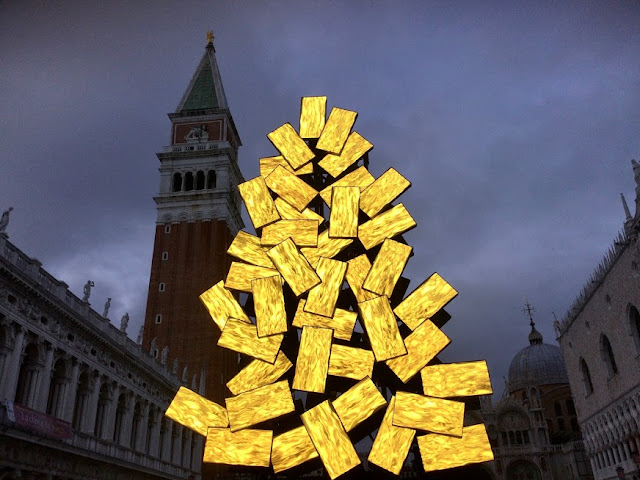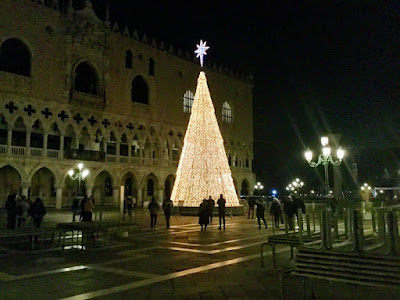(Venice, Italy) There is a debate in Venice about whether or not you like the glowing gold Digital Christmas installation by the international artist Fabrizio Plessi that is currently shimmering in Piazzetta San Marco, made up of more than 80 panels of flowing light. Each river of gold flows in a different direction, symbolically uniting earth, water and sky.
The 80-year-old Plessi was inspired by his deep love of Venice and the gold mosaics that enrich St. Mark's Basilica, which complement his Golden Age waterfalls currently cascading in the windows of the Correr Museum in the heart of Piazza San Marco. (For those not familiar with the geography, the Correr Museum and St. Mark's Basilica bookend Piazza San Marco, so the golden colors perform a celestial dance that arches across the square.) An entire Golden Age installation was also supposed to open last May at Ca' Pesaro, Venice's International Gallery of Modern Art to celebrate Fabrizio Plessi's 80th year, but the global pandemic put a halt to that.
Digital Christmas was intended to be a beacon of hope, light and unity but was met with controversy -- some members of the public understandably would have preferred a giant Rockefeller Center-style traditional tree, an old-fashioned Christmas after a year of being stuck at home, bleary from being confined to computer screens.
 |
| Fabrizio Plessi - The Golden Age at Correr Museum in September - Photo: Cat Bauer |
Long before every person on the planet was running around with a smartphone, Plessi worked with electronic media. As far back as 1968 his artistic focus was on water, which he expressed in film, video installations and performances. The very first time electronic media was shown at a film festival was Plessi's Underwater presented at the Venice Film Festival in 1981. Throughout his long career he has exhibited works throughout the world with titles such as Waterfire, Digital Fall, Digital Islands, Water Fall II, Water Windows, Liquid Labyrinth, Liquid Life, Liquid Light, Splash -- creating liquid electronic images is what Plessi does, so it should be no surprise that he would create Digital Christmas. Like many artists, the 80-year-old Plessi is ahead of his time.
Reality is that Venice has not had a real Christmas tree since 2016. I remember in 2017 when the first all-electric light tree arrived in the
Piazzetta and immediately blew out all the lights in Piazza San Marco. Many people thought that it was instant karma for inflicting an unnatural tree
upon the town.
In 2018 it was worse: a bunch of blue and white electric light spheres in the
shape of a tree that had zero Christmas spirit. The soulless blue tree was not embraced by the public.
In 2019 it was another electric tree, but this time it was forgivable
because Venice had just recovered from the November 12th flood, followed by day upon day of acqua alta. Yet Piazza
San Marco had miraculously managed to pull itself together by November 29th with live Christmas carols
by Vocal Skyline, a gospel choir that filled the square with hope, humanity and good cheer. Just getting a Christmas tree up last year under extreme circumstances was a sign that Venice could hitch up her skirts and clamber back to her feet.
 |
| Digital Christmas by Fabrizio Plessi - Photo: Cat Bauer |
Last week I took an informal survey of the few people who were gathered at the digital tree, taking photos. Everyone was a local because there is basically no one else in Venice right now, and the result was about 20% for and 80% against. One woman told me that Venice is a grande dame, and deserves a grand tree befitting her dignity. A couple from Murano said they liked the installation, but not in Piazza San Marco, and not as the official Christmas tree. The husband said, "We have a great Christmas tree on Murano," and showed me the colorful glass Christmas tree created by the master glass maker Simone Cenedese. Three teen-age girls were taking selfies, and said they did not like it at all and wanted a real tree, basta.
Then I spoke to two little children and asked them if they liked the tree. The boy, who was five-years-old shouted, "Molllllttttooo!!!" which means "very much," but sounded like, "I love it!!!!" and the girl, who was four, sweetly concurred. They seemed fascinated by the cascading gold, each panel traveling in a different direction. An older couple overheard the conversation and said it was because the children were used to digital things, and we are not, which made me wonder if the lockdown has altered their perspective, and now the digital world seems more real to children than the natural world...
Personally, I think Digital Christmas is inspiring, and thought it was beautiful and compelling to watch. To me, the solution would have been to call it an art installation, not a Christmas tree. Then, in addition, a real Christmas tree could have been brought into Piazzetta dei Leoncini, like the ones we used to have, and everyone in Venice could have been invited -- the artisans, the hotels, the shops, the citizens, the children, the churches, the museums, whoever felt like it -- to create a decoration and drop it off at a designated place so that someone official could hang the ornaments on the tree each day, all the way up to Christmas Eve.
It would have been a lovely group project while everyone is stuck at home, and the children could experience the thrill of seeing their creations on display. Then everyone could gather in Piazza San Marco each evening to see which new ornaments had arrived on the real Christmas tree, with Plessi's Digital Christmas in the Piazzetta and his The Golden Age cascading in the windows of the Correr, the natural world and the digital world uniting to illuminate the entire square.
Maybe next year in 2021, for Venice’s 1600th birthday...
Ciao from Venezia,
Cat Bauer







